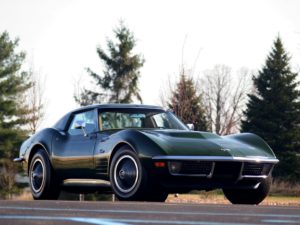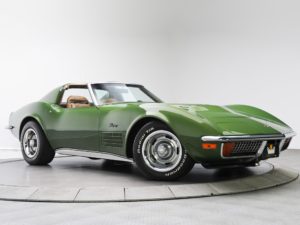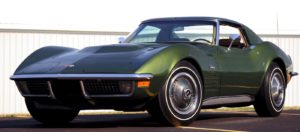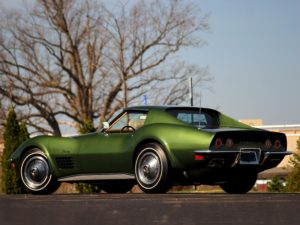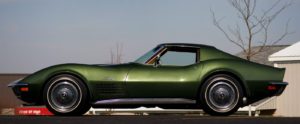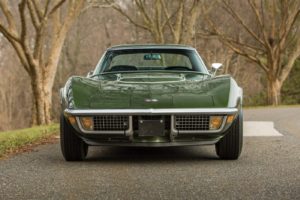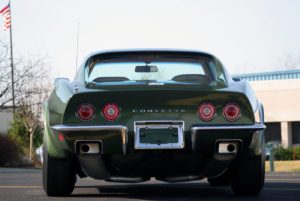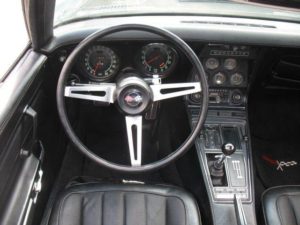The arrival of the 1970 Corvette happened somewhat later than was typical in the automotive manufacturing industry, due in part to the incredible sales backlog that had occurred during the 1969 model year and also due in part to the UAW (United Workers) strike, which delayed the new Corvette from reaching showrooms until February. Along with the Camaro and the Pontiac Firebird, DeLorean believed that prolonging production of the earlier models into the winter of 1969-70 would help Chevrolet make up ground on an order backlog that had occurred in part because of the two-month automotive workers strike at GM plants early in 1969. It was because of this extension that the 1969 Corvette had set record sales numbers for the model year.
On November 7, 1969, Chevrolet manufactured its 250,000th Corvette since production of the sports car had begun on June 30, 1953. Although technically the model should have been a 1970 Corvette, it was still recognized as a 1969 model because of the aforementioned production extension. Interestingly, the 1970 Corvette’s arrival would come at a time when, despite the Corvette’s incredible popularity, it was simultaneously falling under increasing scrutiny for its general lack of overall production value and build quality.
Pricing: $5,192.00 (Coupe), $4,849.00 (Convertible)
Engine options: 350ci – 300HP Engine (standard), 350ci – 370HP Engine, 454ci – 390HP Engine
Transmission: 3-speed manual (standard), 4-speed manual (optional), 3-speed Turbo Hydra-Matic automatic (optional)
Top speed: 144mph
Units produced: 17,316
Available colours: Classic White, Monza Red, Marlboro Maroon, Mulsanne Blue, Bridgehampton Blue, Donnybrooke Green, Daytona Yellow, Cortez Silver, Ontario Orange, Laguna Gray, Corvette Bronze
Highlights of the year:
The 1970 Corvette actually made its formal debut in late February and introduced the world to a number of small, but improved design styling touches. These design changes, which had been introduced on a show car known simply as the Aero Coupe, had included many elements which suggested that the designers were looking to move away from Corvette’s current role as a pure sports car (the ZL-1 notwithstanding) and more towards the blended role of becoming a Luxury Sportscar.
The Aero Coupe had featured an egg-crate patterned grille, matching louvers along the fenders (which replaced the four gills of the 1968 and 1969 model years), and more deeply flared wheel house introduced to reduce the severity of the bodyside tuck-under, which had been discovered as being susceptible to stone damage.
Mechanically, there were many carryovers from the previous model year. The small-block engine lineup remained the same at the two lower power ratings (300 horsepower and 350 horsepower respectively). However, GM did introduce a new solid-lifter, small block engine that they designated the LT-1.
Corvettes equipped with this engine received a special hood dome surrounded by striping and “LT-1” lettering. While these markings were certainly a differentiator between which engine a particular Corvette was built with, it was also readily obvious to anyone who heard the unique rumble from the exhaust pipes and the tapping of its mechanical lifters that they were in the presence of an LT-1 engine.
The numbers that the LT-1 engine produced were impressive, and certainly consistent with the performance expectations that individuals like Zora Arkus-Duntov had for the Corvette.
The LT-1 equipped Corvettes could manage a quarter-mile run in just 14.2 seconds with a top speed of 102 miles per hour, indicating that GM’s published ratings of 370 BHP (brake horsepower) at 6,000rpm and 380lb/ft of torque at 4,000rpm were both on the conservative side.
Of course, many racers looking to utilize the performance and handling aspects of the Corvette were not going to invest their money into a small-block, despite the performance numbers it was capable of producing.
Serious racers knew that, if they were able to sort through the options presented to them, they should have been able to assemble a race car that would rival anything on the track. While earlier Corvettes were capable of being equipped with such options as the ZL-1, (which featured a setup that included the 427 cubic inch L88 engine,) the 1970 offerings were a little harder to come by.
For the 1970 model year, Chevrolet introduced a big block 427 that was stroked out to a full 4.00 inches and 454 cubic inches. It was the first time that the stroke had been increased since the engine had been introduced in its more conservative iteration – a 396 cubic-inch big block – in 1965. While the arrival of the 454 was considered by some to be in response to Corvettes increasing presence on the racetrack, the truth is actually more intriguing. The added cubic inches in the Corvette were actually the byproduct of Chevy’s need to expand the engine’s size to counterbalance the loss of performance in its regular passenger cars due to the mandatory reductions in exhaust emissions as required by state and federal laws.
Still, there was the question of how racers could build a serious track car by using the right combination of production codes. The aforementioned L88 and ZL1 options were even offered for 1970 (though Chevy continued to sell Can-Am engines to bona fide race teams). Instead, GM announced that it would be offering two big-block options: RPO LS5 and LS7. The LS5 would come equipped with hydraulic lifters, 10.25:1 compression, a single, four-barrel carburetor, and was rated at 390 bhp (at 4,800 rpm) with a massive 500lbs/ft of torque.
The 1970 Corvette was one of the first cars during John DeLorean’s tenure as President of General Motors to fall prey to a new pricing plan that took advantage of the car’s unprecedented popularity. DeLorean contested that since each year’s production quota was usually spoken for, and secured by concrete dealer and buyer orders (usually in as early as March or April), that it seemed reasonable that General Motors should actually increase the price of the Corvette more substantially than it had in the previous year – and that is exactly what happened.
The 1970 model year would mark the end for the big-block, high-power Corvettes as they had been known up to this point. A number of factors played into this decision, including skyrocketing insurance rates and a large decline in the sale of sports cars, but the largest contributing factor was a decision made by GM President Ed Cole’s desire to eliminate low-volume options. Further, he dictated that all engines would be required to be able to run on 91-octane fuel, a decision that was made because of the anticipation of the ever-tightening emission regulations that would govern future automotive production.
Photos of the 1970 Corvette:
Sources:
